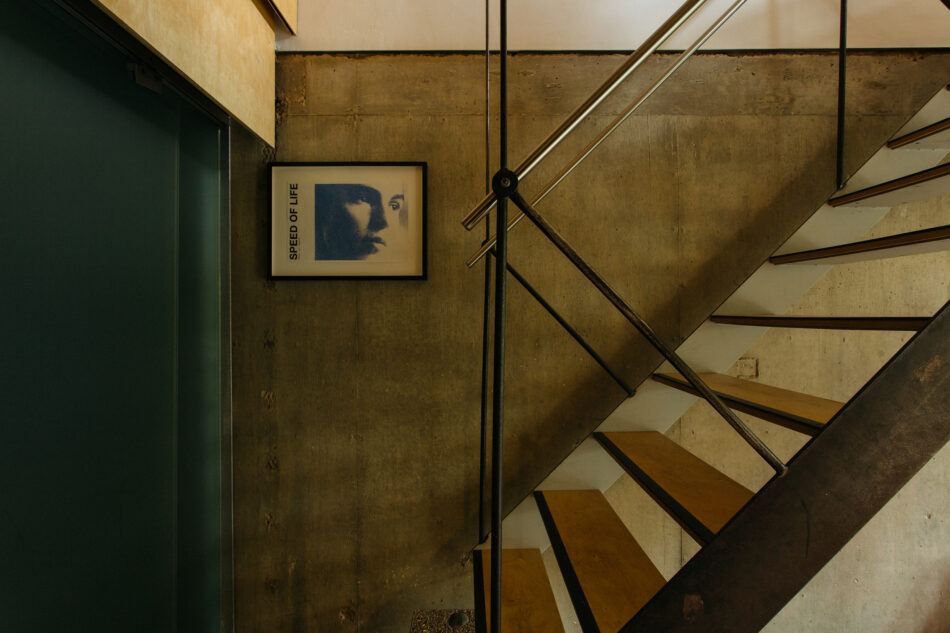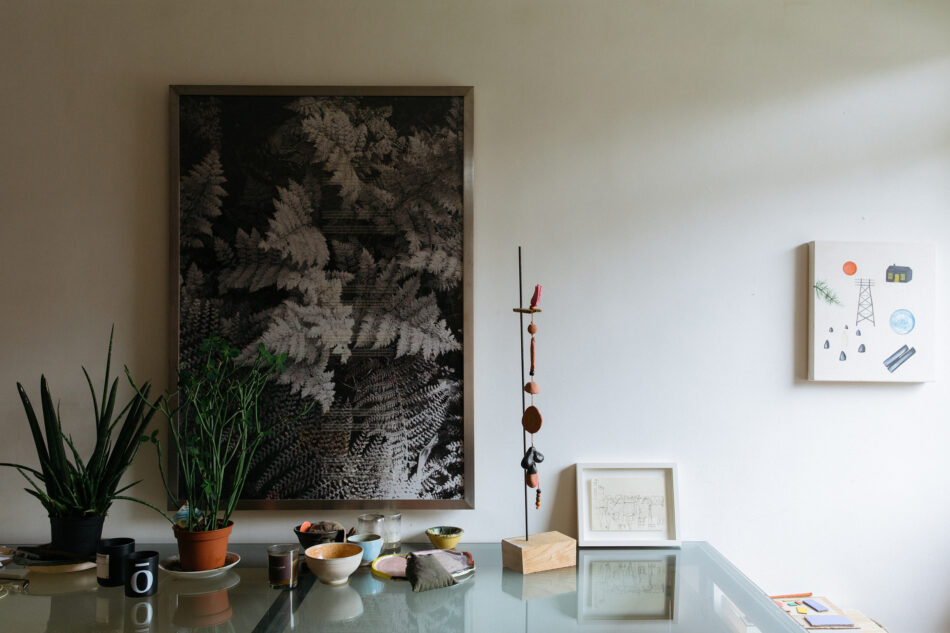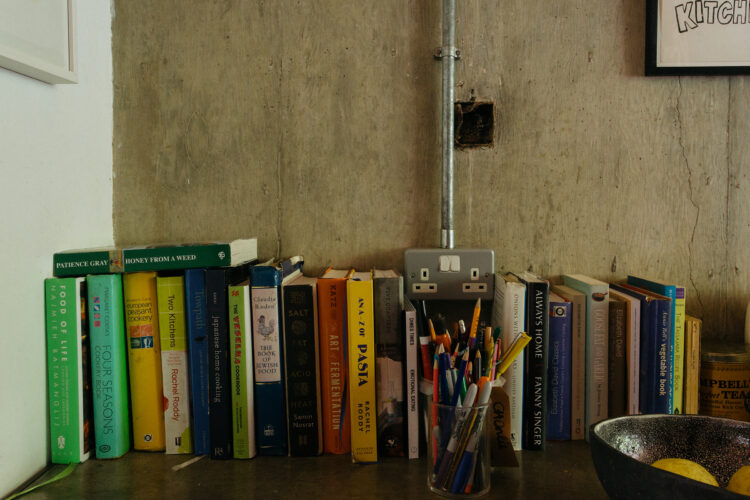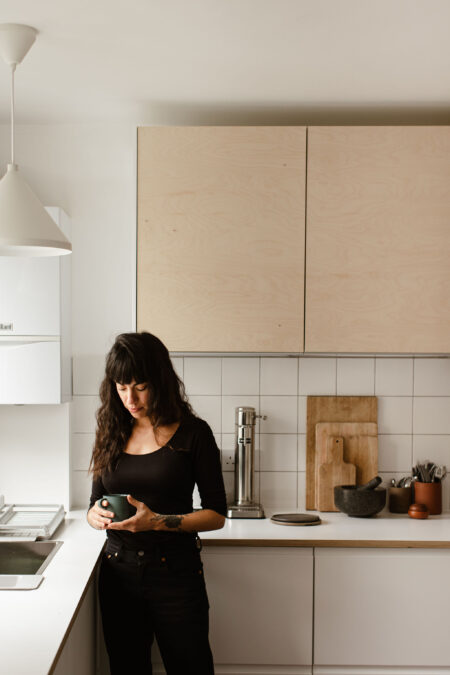House Style with Charlie Porter at his art-filled concrete home in Shoreditch, east London








The home that Charlie Porter, author of What Artists Wear, shares with his husband Richard, an artist, is full of surprises. There’s the juxtaposing material palette of glass, concrete, stone, wood and metal, plus unexpected quirks like the sliding glass ceiling-cum-desk space, and movable walls that create flexible living areas. Meanwhile his art collection, which includes a Charlotte Prodger sculpture and a Prem Sahib neon sign, is enough to compete with that of any contemporary gallery.
Charlie’s home sits within a 1960s ex-council apartment block. Formerly a three-bedroom flat, it was renonvated by design practice architectureAND who aptly titled the project, which was completed in 2008, the ‘DIY house’. It’s far from polished, but that’s exactly the appeal. We sit down with Charlie in the verdant garden of his Shoreditch home, where he shares his House Style.
How would you describe the interiors of your home?
My home is a secret concrete bunker that feels like an architect’s essay.
It’s a two-storey flat that that – in places – has no walls or floors. I’m still finding things out about it five years later that surprise me. There’s a neon light hidden between the two floors, which I recently discovered provides lighting for upstairs as much as for downstairs. The flat was made by architects as a personal project – if you buy a home that has been designed by an architect for a client, there’s inevitably compromise, but because they did this themselves when they were very young, everything is hardcore. It’s a hardcore house to live in and I really enjoy living here.
I’m happiest at home when…
I’m sat in the garden having breakfast in the spring, summer and autumn.
In the winter, I sit on the chair by the big window first thing in the morning, where the light still comes in strong. I also love the bathroom. I like having a bath in the evening with the light there – especially in high summer. And I love being on the sofa with my husband any time of the year, I find it really cosy being in the living room in the evening.
If you could save one thing, what would it be?
Book of Charlie.
It’s a book my husband made for me. It’s a painted story about our life.
What’s your favourite living space around the world?
I’m very happy to be in places that deal with a strong summer, then a colder, bleaker winter.
We’re fond of an island called Milos in Greece, where we stay in whitewashed, converted shepherds’ huts. They’re very simple: a box with a bed, a living area and a toilet and that’s it. The land is protected so there’s nothing else directly around but a shipwreck and, every time you go, it’s a bit more broken. There’s the minimum you need and then the sea in the distance, which just has the most glorious water. I think that yearning comes from living in this country, where it’s unclear what the weather’s going to be.
What was the last thing you bought for the house?
Incense.
I’m a superfan of incense, and I really like the incense by Cremate. It’s incredible stuff, made by mysterious humans around here in east London.I’ve started to light incense in the morning when we’re both awake. I like the positive effect it has on the space. I’m also obsessed with Santa Maria Novella, so we have potpourri everywhere. I like old building smells.
What are your top three coffee table books?
We don’t have a coffee table but we have a cookbook area and I’m completely inspired by food and recipe writing.
I think it’s the highest form of writing and it’s not taken completely seriously. I think when its done seriously there’s alchemy in the words. I always cook lunch for myself and sit outside or on the armchair and read recipe books – I find the logic, language and flow of words inspiring. My top three recipe books are The Book of Jewish Food by Claudia Roden, Honey From A Weed by Patience Gray and I’m completely obsessed with Towpath: Recipes and Stories by Lori De Mori and Laura Jackson. I think it’s the best book ever written.
If money was no object, what changes would you make to the home?
I would – and I’m planning to – do the most sensitive renovation.
It would be an invisible renovation that would leave it looking same. The architects called this the DIY house – they had no budget whatsoever when they did it, so a lot of the cupboards are 1990s Ikea and no longer work – I would like to replace them. If money was no object, I would go space by space, diligently tweaking, fixing, replacing. We would do a lot of work to make it exactly as it is.
You’re having friends over for dinner: what do you cook?
We’re lucky that we’re close to Leila’s Shop, the best shop in the world.
Everything is seasonal in the best sense of the word. Right now, she has these insane, huge tomatoes and the most gorgeous bread from E5 Bakehouse so we would get a loaf and make a Panzanella tomato salad. The night before we’d fry steak from The Butchery in Spitalfields Market and let it rest coated in garlic and rosemary butter. We’d leave it in the fridge overnight, then slice it and have it cold. We’d fry some courgettes in garlic, make a quick green salad and have it all with homemade hummus. Then it’s fruit galette for afters.
What does a Sunday look like here?
Often, I go to Columbia Road at 8am.
I’ll bring back three or four things that I just haven’t got space for, then potter about, then have a roast.
What are the best things about the neighbourhood?
There are two very different sides to Shoreditch.
There’s the chaos of the high street, but there’s also this completely gorgeous community. It’s an incredible place to live. And there’s Arnold Circus, a garden in the middle of one of the first examples of social housing, where I volunteer. The reality is it’s a hell of a lot of sweeping, mulching, clearing rubbish – it’s a lot of labour and then we talk about plants. Its an amazing group of people and we always have tea and cake together. There’s nowhere else like Arnold Circus.























